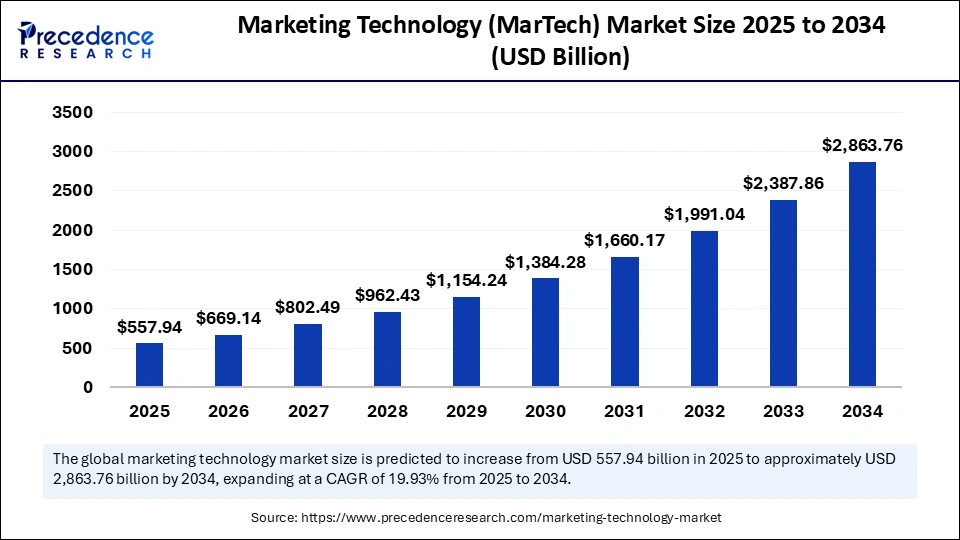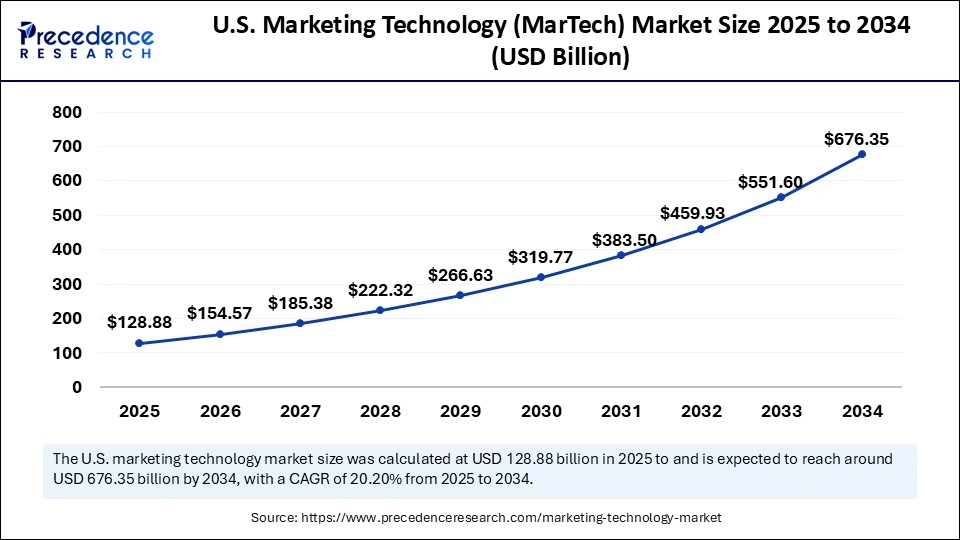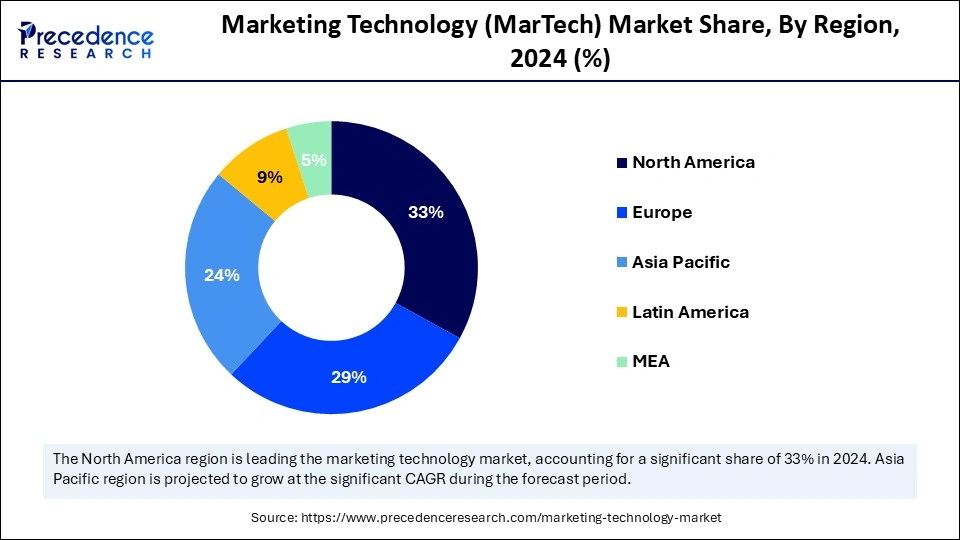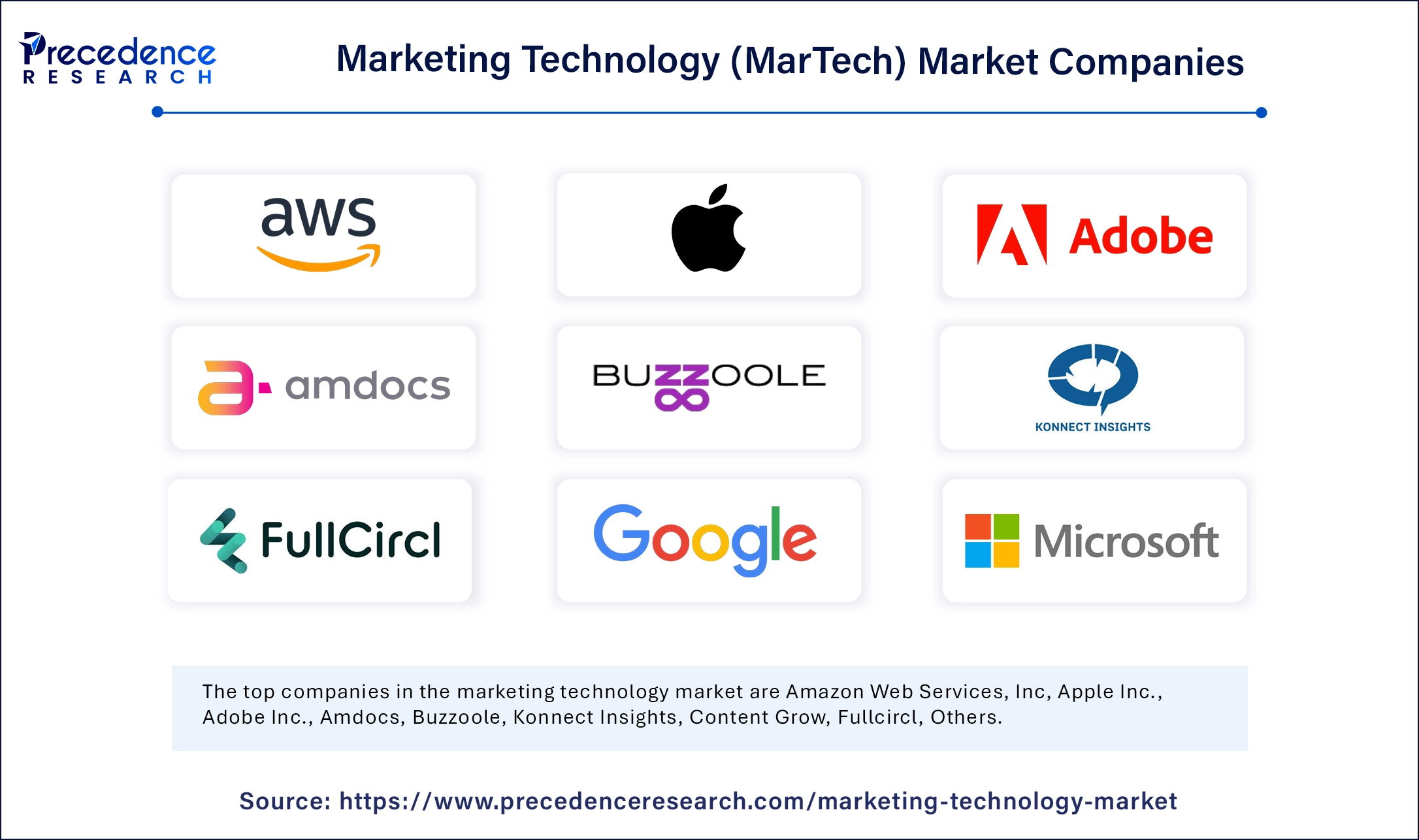The global marketing technology (MarTech) market size is calculated at USD 557.94 billion in 2025 and is forecasted to reach around USD 2,863.76 billion by 2034, accelerating at a CAGR of 19.93% from 2025 to 2034. The North America market size surpassed USD 153.52 billion in 2024 and is expanding at a CAGR of 20.11% during the forecast period. The market sizing and forecasts are revenue-based (USD Million/Billion), with 2024 as the base year.
The global marketing technology (MarTech) market size accounted for USD 465.22 billion in 2024 and is predicted to increase from USD 557.94 billion in 2025 to approximately USD 2,863.76 billion by 2034, expanding at a CAGR of 19.93% from 2025 to 2034. The widespread adoption of digital technologies by businesses across the world is expected to boost the growth of the market during the forecast period.

Artificial Intelligence has completely transformed the landscape of marketing in the last few years. AI-driven tools can optimize chatbots and smart assistants, leading to improved customer interactions. AI technology automates tasks such as monitoring social media, answering simple customer queries, and managing email marketing campaigns. Automating such tasks frees the professionals to focus on other tasks requiring their attention. With AI technology, marketing workflows can be optimized, ensuring efficient and smooth operations.
Personalization of content for the customer is a major benefit of utilizing AI in marketing technology. By analyzing customer data, AI helps offer customers personalized experiences through visuals, ads, or content that suits their preferences. Another advantage of AI technology is that it helps with data analytics. AI can help marketing professionals make decisions based on insights into marketing campaign performance, market trends, and user behavior. AI enhances efficiency and provides a personalized customer experience.
The U.S. marketing technology (MarTech) market size was exhibited at USD 107.47 billion in 2024 and is projected to be worth around USD 676.35 billion by 2034, growing at a CAGR of 20.20% from 2025 to 2034.

North America held the largest share of the marketing technology (MarTech) market in 2024. The widespread adoption of marketing technologies in various industries across the region is a key factor that contributed to the region’s market dominance. The region is expected to sustain its position in the market in the coming years. Every industry today needs robust marketing solutions, which will help drive the growth of this market. The popularity of platforms like Shopify, Magneto, and WooCommerce in the region has boosted the demand for marketing technologies in the retail sector. The rapid shift toward digital transformations and the rising utilization of smartphones further support market growth.
The U.S. plays a major role in the North American marketing technology (MarTech) market. The country is a hub for technological advancements and innovation, along with the strong presence of key players of this market, which is a major factor supporting market growth. There is a high level of adoption of marketing technologies among businesses to boost customer experience and satisfaction, contributing to market expansion.

Asia Pacific is projected to witness the fastest growth in the upcoming period. The rising Internet penetration and the increasing adoption of smartphones are major factors boosting the growth of the market in the region. Rapid digitalization in countries like India and China further boosts the demand for marketing technologies. The rise of e-commerce and the increasing demand for digital content are expected to boost the growth of the market in the region.
Europe is projected to show notable growth during the forecast period. The rising focus on improving consumer experience is a key factor boosting the growth of the market in the region. There are several MarTech companies in the region that are working on developing advanced marketing solutions. The growing focus of organizations toward developing targeted and effective marketing strategies further propels market growth.
Marketing technologies (MarTech) have been changing the landscape of the marketing industry in the last few years. MarTech allows businesses to directly reach consumers in a more effective manner with data-driven strategies and digital tools. The rising penetration of Internet services and the boom of social media are boosting the demand for marketing technologies. The adoption of omnichannel marketing by businesses has been a key factor in the growth of this market. With the rapid shift toward digital transformation, the adoption of marketing technologies is increasing.
The rising emphasis on customer satisfaction and engagement by organizations is boosting market growth. Marketing technology allows marketing professionals to make informed decisions. This helps professionals quickly adapt to changing user behavior and tweak their marketing strategies when necessary. Advancements in technologies like AI, Machine Learning, and big data improve the consumer experience and reliability of MarTech, which further drives market growth.
| Report Coverage | Details |
| Market Size by 2034 | USD 2,863.76 Billion |
| Market Size in 2025 | USD 557.94 Billion |
| Market Size in 2024 | USD 465.22 Billion |
| Market Growth Rate from 2025 to 2034 | CAGR of 19.93% |
| Dominating Region | North America |
| Fastest Growing Region | Asia Pacific |
| Base Year | 2024 |
| Forecast Period | 2025 to 2034 |
| Segments Covered | Product, Type, Application, Region |
| Regions Covered | North America, Europe, Asia-Pacific, Latin America, and Middle East & Africa |
Growth of Omnichannel Marketing
The growing focus by businesses on omnichannel marketing is a key factor driving the growth of the marketing technology (MarTech) market. Organizations are placing emphasis on enhancing customer experience across various channels and touchpoints. This shift in marketing toward omnichannel directly boosts the demand for marketing technologies. For instance, a survey by Aspect Software revealed that there is a 91% greater year-over-year customer retention rate for organizations in the retail sector that utilize omnichannel marketing strategies. This trend of using omnichannel has brought ahead the importance of consistency in branding. With the availability of technologically advanced tools, the integration of omnichannel marketing has become seamless for businesses. By using these marketing tactics, companies can enhance customer satisfaction and retention rates, reflecting positively on the brand’s presence and identity. The omnichannel marketing campaigns have the potential to achieve a 287% higher purchase rate.
Complexity and Integration Issues
Combining multiple tools and platforms makes it challenging to integrate and manage them, which is a key factor restraining the growth of the marketing technology (MarTech) market. This difficulty in integration leads to data silos and inefficiencies, hindering the proper functioning of these tools. For instance, according to the American Marketing Association (AMA), about 44% of the marketing teams in the U.S. are utilizing four or more tools at once to execute their strategies successfully. Complexities in integrating multiple tools affect the success rate and efficiency of the marketing campaigns. Key players operating in the market must focus on developing and updating more user-friendly tools that enable easy integration.
Adoption of AR, VR, and XR
The utilization of Augmented Reality, Virtual Reality, and Extended Reality (XR) in marketing technology (MarTech) offer new growth opportunities for the market. These technologies provide marketing campaigns with better options to improve the interactivity as well as immersivity of their strategies. With the help of such advanced technologies, organizations can create more interactive advertisements, which will boost impact or product demonstration that can help the business stand out. XR helps enhance customer engagement and offers innovative marketing opportunities, which can help develop customer loyalty and satisfaction.
The social media tools segment dominated the marketing technology (MarTech) market in 2024. The exponential use of social media by consumers bolstered the growth of this segment. These tools help manage social media content, advertising, analytics, content creation, and influencer marketing. Such features allow businesses to create effective strategies and organize their marketing through social media. Scheduling posts, real-time engagement, generating targeted advertisements, and editing are possible through these tools, making them a popular choice.
The sales enablement tools segment is expected to show significant growth in the coming years. These tools are necessary to boost the productivity of sales teams in businesses. Improvements in communication, user access to necessary information, analytics, reporting, and links with CRM systems are possible due to these tools. The use of these tools helps increase sales and revenue, supporting the segment’s growth.
The digital marketing segment led the marketing technology (MarTech) market in 2024. More and more businesses are regularly investing in MarTech. The rise in the adoption of various marketing technologies to maintain a competitive edge bolstered this segment’s growth. Moreover, technological advancements in marketing platforms, SEO tools, and advertising technologies are further boosting the growth of this segment. Digital marketing tools offer organizations an effective and reliable way to optimize their marketing campaigns and online presence for business growth.
The offline marketing segment is anticipated to expand at a significant CAGR during the forecast period. This segment comprises traditional marketing channels that do not use any digital technologies. Combining traditional and digital marketing can foster customer relationships, boost brand awareness, and target local consumers. This helps reach a broader base, forging stronger relationships.
The healthcare segment dominated the marketing technology (MarTech) market in 2024. This is mainly due to a strong emphasis of the healthcare sector on digital transformation, especially in the aftermath of the COVID 19 pandemic. The widespread application and integration of digital technologies to cater to changing consumer needs is boosting segment growth. Healthcare businesses are utilizing digital tools to run effective marketing campaigns, enhancing offerings for patients through data analysis and tracking key indicators. The use of MarTech by healthcare organizations helps increase brand awareness, widen the reach, and help enhance access to healthcare.
The retail & e-commerce segment is expected to grow at a rapid pace during the projection period. The rapid growth of the retail as well as e-commerce industry has been possible through effective marketing. Utilizing various marketing technologies helps these industries capitalize on data-driven insights, offer personalized experiences, boost efficiency in operations, and design targeted marketing. The increase in accessibility and availability of internet and smartphones further contributes to the segment's growth.

By Product
By Type
By Application
By Region
For inquiries regarding discounts, bulk purchases, or customization requests, please contact us at sales@precedenceresearch.com
No cookie-cutter, only authentic analysis – take the 1st step to become a Precedence Research client